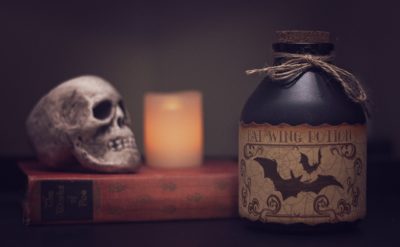
The cool October embraces, and most of us—if we’re being honest—are drawn to the scary things as Halloween looms. Stories of darkness and horror whisper to us, in movies, television, graphic arts, and literature.
Lovers of the literary, do not despair! Chills and frights are not all about slashers and gore. Illustrious writers from Shakespeare to Faulkner to Levin have dabbled in the macabre. It’s okay to be scared. But we don’t turn to the great authors for buckets of blood. We turn to them for insights and inventive use of language.
Take stream of consciousness prose, for example. It tickles the mind when done well, adding layers of meaning and tension to a story. We appreciate that James Joyce, Virginia Woolf, and Dorothy Richardson invented and bequeathed to us this great gift of narrative.
Except that that’s not entirely accurate. Two decades before Joyce and Woolf and Richardson, Ambrose Bierce, in his remarkable short story, “An Occurrence at Owl Creek Bridge” (1890), employed stream of consciousness, rubbing elbows with psychological horror and science fiction in its sudden dilation of time at the moment of death.
Let’s go back even farther, to 1843, and examine Edgar Allan Poe’s short story, “The Tell Tale Heart.” The story opens thusly:
TRUE!—nervous—very, very dreadfully nervous I had been and am; but why will you say that I am mad? The disease had sharpened my senses—not destroyed—not dulled them. Above all was the sense of hearing acute. I heard all things in the heaven and in the earth. I heard many things in hell. How, then, am I mad?
In my August blog, I talked about unreliable narrators, using “The Tell Tale Heart” as an example. The narrator tells it like it is, tells the truth, or at least as he understands it. But it’s apparent from the start that he’s mentally unhinged. Or is he? That’s part of the appeal of unreliable narrators; truth is not an absolute. It provides a vehicle for experimentation, and Poe opens the floodgate and lets the words flow in a torrent, increasing in velocity to the final paragraphs, as the narrator describes the sound of his dead victim’s heartbeat:
It was a low, dull, quick sound—much such a sound as a watch makes when
enveloped in cotton. I gasped for breath—and yet the officers heard
it not. I talked more quickly—more vehemently; but the noise steadily
increased. I arose and argued about trifles, in a high key and with
violent gesticulations; but the noise steadily increased. Why would
they not be gone? I paced the floor to and fro with heavy strides, as if
excited to fury by the observations of the men—but the noise steadily
increased. Oh God! what could I do? I foamed—I raved—I swore! I swung
the chair upon which I had been sitting, and grated it upon the
boards, but the noise arose over all and continually increased. It
grew louder—louder—louder! And still the men chatted pleasantly, and
smiled. Was it possible they heard not? Almighty God!—no, no! They
heard!—they suspected!—they knew!—they were making a mockery of my
horror!—this I thought, and this I think. But anything was better than
this agony! Anything was more tolerable than this derision! I could bear
those hypocritical smiles no longer! I felt that I must scream or die!
and now—again!—hark! louder! louder! louder! louder!
That may not mirror stream of consciousness as understood today, but it certainly foreshadows it. This was groundbreaking stuff. So kick back, light the jack-o-lanterns, eat more candy than you hand out, and dive into a few scary classics, as much for the literary tricks and treats as for the scares.
You’ve been good readers, kids. As a bonus treat, enjoy Poe’s atmospheric “The Raven,” courtesy of James Earl Jones and Homer Simpson:

Jill
Hi Ken,
Thank you for drawing out the importance of how Halloween can inspire writers.
I just published a short story from The Silver Empire: Lyonesse Press called “Machete and he Witch’s Broom.” Although the narrator is unreliable as well–but in a different way–not because of his discretionary state of mind, but because of his faltering courage.
Ken Pelham
Thanks, Jill! We all can enjoy a little scary treat now and then, even if it’s not on our usual menu. I mentioned Faulkner above; his 1930 short story, “A Rose for Emily,” has always been a favorite, and it fits nicely among the traditions of horror and the macabre.
Elle Andrews Patt
Stream-of -consciousness is absorbing when it’s done well. Love the short film, “An Occurrence At Owl Creek Bridge”, but never wondered where it came from! Now I’m really interested to read it and study this early example of the technique. I’ll also have to read “A Rose For Emily”. Thanks, Ken!
Ken Pelham
I’m here to serve, Elle.
In writing this piece, I found that short film of “An Occurrence at Owl Creek Bridge” on YouTube. I didn’t know of it before, but it was apparently made in France, was snapped up by Rod Serling, and aired as an episode of “The Twilight Zone.” They ran it once, but couldn’t air it again when the show went into syndication.
Ken Pelham
Oh, and as an added bonus, “A Rose for Emily” is also an example of the extremely rare first-person plural viewpoint. The whole town is the narrator, “we.”